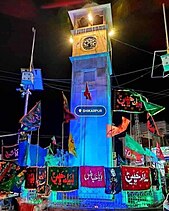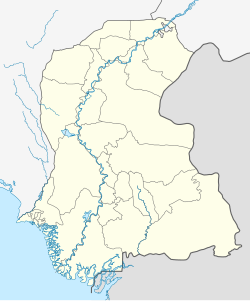Shikarpur, Sindh
Shikarpur
| |
|---|---|
From top, left to right: Historical Building, Clock Tower, Shahi Bagh Park, Dhak Bazar, Old building of Central Bank of India. | |
| Nickname: Paris Of Sindh[1] | |
| Coordinates: 27°57′N 68°39′E / 27.950°N 68.650°E | |
| Country | |
| Province | Sindh |
| Elevation | 13 m (43 ft) |
| Population | |
• City | 204,938 |
| • Rank | 42nd, Pakistan |
| Time zone | UTC+5 (PST) |
| Post code | 78100 |
| Calling code | 0726 |
Shikarpur (Sindhi: شڪارپور; Śikārpūr) is a city and the capital of Shikarpur District in Sindh province of Pakistan. It is situated about 29 km west of the right bank of the Indus, with a railway station, 37 km north-west of Sukkur. It is the 42nd largest city of Pakistan by population according to the 2017 census.
History
[edit]Shikarpur was founded in 1677 as the hunting ground of Mahars.[3] Shikarpur, the seat of civilisation, culture, trade and commerce acquired political and economic importance because of its strategic location on the map of Sindh, being directly accessible to those who came from Central and West Asia through the Bolan Pass. In the early 17th century this emerald city in the northern Sindh province of Pakistan became the nucleus of a historical trade center on a caravan route through the Bolan Pass into Afghanistan. Shikarpur became the core of manufactures including brass and metal goods, carpets, cotton cloth, and embroidery. Its great bazaar (covered because of the summer heat) is famous throughout Turkistan and southern Asia.[4]
The predominantly Muslim population of Sindh supported Muslim League and Pakistan Movement. After the independence of Pakistan in 1947, the minority Hindus migrated to India while the Muslims refugees from India settled down in the Shikarpur District. However, like many urban areas in Sindh, the city of Shikarpur was predominantly populated by Hindus prior to the partition of India.[5][6]
Demography
[edit]The population of Shikarpur District was estimated to be 1,231,481 in 2017.[7] The predominant population is Sindhi. There are significant Urdu, Baloch, Brahui, speaking communities in Shikarpur. The population is mainly Muslim. There is a small Hindu minority in the city as most Hindus migrated to India after independence in 1947.
Geography
[edit]Shikarpur District has an area of 2640 square kilometers, divided into four "talukas":
- Shikarpur, Sindh.
- Lakhi.
- Garhi Yasin .
- Khanpur, Sindh.
Its borders meet with districts of Larkana, Jacobabad, Khairpur & Sukkur. Two National Highways (N-65 & N-55) intersect in the city of Shikarpur, so it can well be termed as, one of the junction points of the four provinces.
The district has a total road length of 920.0 kilometers, including 125.0 kilometers of National Highways and 195.0 kilometers of Provincial Highways. It is, thus, deficient in road density (0.35 km/Km2) compared with recognized international parameters of development (1 km/Km2). During the last few years, creeping development activity has taken place and 71.0 kilometers of road, 94 schools and a number of schemes in drainage, health and other sectors have been completed, under various programs. Basically, agrarian economy of district Shikarpur is dependent upon non-perennial irrigation system, so the district is always in semi-drought conditions. The last spell of drought is particularly notable as it created heavy unemployment and unsustainable poverty, which without any doubt created serious law and order situations.
Boundaries
[edit]The District is bounded on the north and east by Jacobabad District in the south by Sukkur District on the west by Indus River and Larkana District.
Gates of Shikarpur
[edit]The town consists of seven gates named Lakhi-dar, Hathi-dar, Hazari-dar, Civi-dar, Karan-dar, Wagono-dar, Khanpur-dar, and one window named Siddiqui Mari.
Covered Market or Dhak Bazar
[edit]Located in the center of the old city, Dhak Bazaar or covered market is a long, narrow street with shops on either sides. It is covered with woodwork of pure teak. It has been serving as a cool shade during the hot summers. Shikarpur along with other contemporary cities like Bukhara, Samarkand, and Istanbul at that time had a covered street market.
Healthcare
[edit]- Rai Bahadur Udhaudas Tarachand Hospital (Civil Hospital)
- Hiranand Gangabai Ladies Hospital
Education
[edit]Notable educational institutes located in Shikarpur include Shaikh Ayaz University and Chellaram and Seetaldas College.[8] Institutes have their own libraries, but there is only one public library in Shikarpur named "Qadir Bux Bedil Library".
Notable People
[edit]- Aftab Shaban Mirani
- ALi Gohar Khan Baloch
- Allah Bakhsh Soomro
- Badam Natawan
- Bedil Masroor
- Chainrai Bachomal Sami
- Elahi Bux Soomro
- Ghulam Hussain Hidayatullah
- Khialdas Fani
- Naseem Thebo
- Rahim Bux Soomro
- Shaikh Ayaz
- Sufi Budhal Faqeer
- Sumaira Zareen
- Ram Jethmalani
- G. V. Desani
- Imtiaz Ahmed Shaikh
- Haji Abdul Ghaffar Siddiqui
- Khan Bahadur Muhammad Daim Khan Siddiqui
- Jamal M Siddiqui Advocate
Gallery
[edit]-
Old building architecture of Shikarpur
-
Deewan Ramchand's historical restaurant is very famous for its Sweets and Kulfi-Falooda
-
Samosa Making at Hathi dar Shikarpur
-
Shikarpur Saif plaza
-
Shahi Bagh
See also
[edit]References
[edit]- ^ "The Paris of Sindh". The Express Tribune (newspaper). 11 January 2020. Retrieved 10 January 2021.
- ^ "Sindh: Province and Major Cities, Municipalities & Towns". Sindh: Province and Major Cities, Municipalities & Towns. Citypopulation.de. Retrieved 4 May 2020.
- ^ Everett-Heath, John (22 October 2020). "Shikarpur". Concise Oxford Dictionary of World Place Names. Oxford University Press. doi:10.1093/acref/9780191905636.001.0001/acref-9780191905636-e-6817.
- ^ Memories of Shikarpur, the Paris of Sindh
- ^ Markovits, Claude (2000). "The Gate of Khorrassan: the Shikarpuri network, c. 1750–1947". The Global World of Indian Merchants, 1750–1947: Traders of Sind from Bukhara to Panama. Cambridge Studies in Indian History and Society. Cambridge: Cambridge University Press. p. 62. doi:10.1017/cbo9780511497407. ISBN 978-0-521-62285-1. OCLC 1264046795.
- ^ Lambrick, H. T. Census of India, 1941 VOL. XII SIND (Tables). Delhi: Published by the Manager of Publications
- ^ "Population and household detail from block to district level" (PDF). www.pbs.gov.pk.
- ^ "Becoming history: The plunder of Shikarpur by its very own sons". May 2012.
General references
[edit]- Markovits, Claude The Global World of Indian Merchants 1750-1947 Traders of Sind from Bukhara to Panama, Cambridge, Cambridge University Press, 2004, pp. 65–217.










